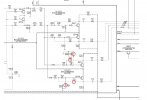Greetings,
Great forum. First-time poster - sorry if I'm in wrong category.
I have an older CD-player/amp combination (Panasonic sa-pm193) that I want to use for a specific application. Though it is a stereo system, each stereo channel is divided into high and low frequencies, each with separate speaker outputs. That is, each stereo channel has outputs for two speakers: a high-frequency (tweeter) and a low-frequency (actually a mid-range). So, meant to use four speakers.
The problem is that I want to feed the hi and low outputs for each stereo channel into one (full-range) speaker. So, I would then have a two-speaker system. But, not sure how best to accomplish this.
An obvious route would be to just jump the plus to the plus, and minus to minus, for each stereo channel. It seems to me that this should be okay but I didn't want to risk either amp or speakers without an educated opinion.
Thanks for help, and for any better idea if required.
Great forum. First-time poster - sorry if I'm in wrong category.
I have an older CD-player/amp combination (Panasonic sa-pm193) that I want to use for a specific application. Though it is a stereo system, each stereo channel is divided into high and low frequencies, each with separate speaker outputs. That is, each stereo channel has outputs for two speakers: a high-frequency (tweeter) and a low-frequency (actually a mid-range). So, meant to use four speakers.
The problem is that I want to feed the hi and low outputs for each stereo channel into one (full-range) speaker. So, I would then have a two-speaker system. But, not sure how best to accomplish this.
An obvious route would be to just jump the plus to the plus, and minus to minus, for each stereo channel. It seems to me that this should be okay but I didn't want to risk either amp or speakers without an educated opinion.
Thanks for help, and for any better idea if required.


